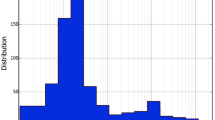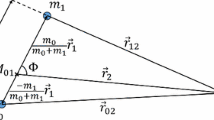Abstract
The eccentric Kozai–Lidov mechanism, based on the secular theory, has been proposed as a mechanism that plays an important role in producing orbits that switch from prograde to retrograde. In the present work we study the secular dynamics of a triple system composed of a Sun-like central star and a Jupiter-like planet, which are under the gravitational influence of another perturbing star (brown dwarf). The perturbation potential is developed in closed form up to the fifth order in a small parameter (\(\alpha =a_{1}/a_{2}\)), where \(a_{1}\) is the semimajor axis of the extrasolar planet and \(a_{2}\) is the semimajor axis of the perturbing star. To eliminate the short-period terms of the perturbation potential, the double-average method is applied. In this work we do not eliminate the nodes, a standard method in the literature, before deriving the equations of motion. The main goal is to study the effects of the higher-order terms of the expansion of the perturbing force due to the third body in the orbital evolution of the planet. In particular, we investigate the inclination and the shape (eccentricity) of these orbits. We show the importance of the higher-order terms in changing the inversion times of the flip, i.e., the times where the inclination of the inner planet flips from prograde to retrograde trajectories. We also show the dependence of the first flip with respect to the semimajor axis and eccentricity of the orbit of the planet. The general conclusion is that the analytical model increases its accuracy with the inclusion of higher-order terms. We also performed full numerical integrations using the Bulirsch–Stoer method available in the Mercury package for comparison with the analytical model. The results obtained with the equations developed in this work are in accordance with direct numerical simulations.






















Similar content being viewed by others
References
Albrecht, S., Winn, J.N., Johnson, J.A., et al.: Obliquities of Hot Jupiter host stars: evidence for tidal interactions and primordial misalignments. Astrophys. J. 757(1), 18 (2012)
Antonini, F., Murray, N., Mikkola, S.: Black hole triple dynamics: breakdown of the orbit average approximation and implications for gravitational wave detections. Astrophys. J. 781(1), 45 (2014)
Beaugé, C., Ferraz-Mello, S., Michtchenko, T.A.: Multi-planet extrasolar systems detection and dynamics. Res. Astron. Astrophys. 12(8), 1044–1080 (2012)
Bode, J.N., Wegg, C.: Production of EMRIs in supermassive black hole binaries (2013) arXiv:1310.5745v1
Brouwer, D.: Solution of the problem of an artificial satellite, theory without drag. Astron. J. 64(9), 378–397 (1959)
Brouwer, D., Clemence, G.M.: Methods of Celestial Mechanics. Academic Press, New York (1961)
Carvalho, J.P.S., Vilhena de Moraes, R., Prado, A.F.B.A., Winter, O.C.: Analysis of the secular problem for triple star systems. J. Phys. Conf. Ser. 465, 1–6 (2013). doi:10.1088/1742-6596/465/1/012010
Chambers, J.E.: A hybrid symplectic integrator that permits close encounters between massive bodies. Mon. Not. R. Astron. Soc. 304, 793–799 (1999)
Correia, A.C.M., Laskar, J., Farago, F., Boué, G.: Tidal evolution of hierarchial and inclined systems. Celest. Mech. Dyn. Astron. 111, 105–130 (2011)
Correia, A.C.M., Boué, G., Laskar, J.: Pumping the eccentricity of exoplanets by tidal effect. Astrophys. J. Lett. 744(L23), 1–5 (2012)
Ford, E.B., Kozinsky, B., Rasio, F.A.: Secular evolution of hierarchical triple star systems. Astrophys. J. 535, 385–401 (2000)
Ford, E.B., Kozinsky, B., Rasio, F.A.: ERRATUM: “Secular evolution of hierarchical triple star systems” (Astrophys. J. 535, 385 [2000]). Astrophys. J. 605, 966 (2004)
Harrington, R.: The stellar three-body problem. Celest. Mech. 1, 200–209 (1969)
Hori, G.: The motion of a hyperbolic artificial satellite around the Oblate Earth. Astron. J. 66(6), 258–263 (1961)
Jefferys, W.H., Moser, J.: Quasi-periodic solutions for the three-body problem. Astron. J. 71(7), 568–578 (1966)
Katz, B., Dong, S., Malhotra, R.: Long-term cycling of Kozai–Lidov cycles: extreme eccentricities and inclinations excited by a distant eccentric perturber. Phys. Rev. Lett. 107, 181101 (2011)
Kovalevsky, J.: Introduction to Celestial Mechanics. D. Reidel, Dordrecht (1967)
Kozai, Y.: Secular perturbations of asteroids with high inclination and eccentricity. Astron. J. 67(9), 591 (1962)
Krymolowski, Y., Mazeh, T.: Studies of multiple stellar-II. Second-order averaged hamiltonian to follow long-term orbital modulations of hierarchical triple systems. Mon. Not. R. Astron. Soc. 304, 720–732 (1999)
Laskar, J., Boué, G.: Explicit expansion of the three-body disturbing function for arbitrary eccentricities and inclinations. Astron. Astrophys. 522(A60), 1–11 (2010)
Lee, M.H., Peale, S.J.: Secular evolution of hierarchical planetary systems. Astrophys. J. 592, 1201–1216 (2003)
Li, G., Naoz, S., Holman, M., Loeb, A.: Chaos in the test particle eccentric Kozai–Lidov mechanism. Astrophys. J. 791(86), 1–10 (2014a)
Li, G., Smadar Naoz, S., Kocsis, B., Loeb, A.: Eccentricity growth and orbit flip in near-coplanar hierarchical three-body systems. Astrophys. J. 785:116, 1–8 (2014b)
Lidov, M.L.: The evolution of orbits of artificial satellites of planets under the action of gravitational perturbations of external bodies. Planet. Space Sci. 9, 719–759 (1962)
Lithwick, Y., Naoz, S.: The eccentric Kozai mechanism for a test particle. Astrophys. J. 742(94), 1–8 (2011)
Naoz, S., Farr, W.M., Lithwick, Y., Rasio, F.A., Teyssandier, J.: Hot jupiters from secular planet–planet interations. Nature 473, 187–189 (2011)
Naoz, S., Farr, W.M., Lithwick, Y., Rasio, F.A., Teyssandier, J.: Secular dynamics in hierarchical three-body systems. MNRAS 431, 2155–2171 (2013)
Naoz, S., Farr, W.M., Rasio, F.A.: On the formation of hot jupiters in stellar binaries. Astrophys. J. Lett. 754(L36), 1–6 (2012)
Petrovich, C.: Hot jupiters from coplanar high-eccentricity migration. Astrophys. J. 805(1), 75 (2015a)
Petrovich, C.: Steady-state planet migration by the Kozai-Lidov mechanism in stellar binaries. Astrophys. J. 799(1), 27 (2015b)
Prado, A.F.B.A.: Third-body perturbation in orbits around natural satellites. J. Guid. Control Dyn. 26(1), 33–40 (2003)
Takeda, G., Kita, R., Rasio, F.A.: Planetary systems in binaries. I. Dynamical classification. Astron. J. 683, 1063–1075 (2008)
Tremaine, S., Touma, J., Namouni, F.: Satellite dynamics on the laplace surface. Astron. J. 137, 37063717 (2009)
Triaud, A.H.M.J., Collier, C.A., Queloz, D., et al.: Spin-orbit angle measurements for six southern transiting planets. New insights into the dynamical origins of hot Jupiters. Astron. Astrophys. 524(A25), 1–10 (2010)
Valtonen, M., Karttunen, H.: The three-body problem. Cambridge University Press, Cambridge (2006)
Yokoyama, T., Vieira Neto, E., Winter, O. C., Sanchez, D. M., Brasil, P.I.O.: On the evection resonance and its connection to the stability of outer satellites. Math. Probl. Eng. Article ID 251978, 16 (2008). doi:10.1155/2008/251978
Yokoyama, T., Santos, M.T., Gardin, G., Winter, O.C.: On the orbits of the outer satellites of Jupiter. Astron. Astrophys. 401, 763–772 (2003)
Acknowledgments
Sponsored by CNPq—Brazil. The authors are grateful to CNPq (National Council for Scientific and Technological Development)–Brazil for contracts 306953/2014-5, 304700/2009-6, and 303070/2011-0, FAPESP (Foundation to Support Research in São Paulo State) SP-Brazil under Contracts 2011/08171-3, 2011/05671-5, 2012/21023-6, and 2014/06688-7 and CAPES. We thank Dr. Denilson Paulo Souza dos Santos and Dr. André Izidoro Ferreira da Costa for help with some Maple commands.
Author information
Authors and Affiliations
Corresponding author
Rights and permissions
About this article
Cite this article
Carvalho, J.P.S., Mourão, D.C., de Moraes, R.V. et al. Exoplanets in binary star systems: on the switch from prograde to retrograde orbits. Celest Mech Dyn Astr 124, 73–96 (2016). https://doi.org/10.1007/s10569-015-9650-3
Received:
Revised:
Accepted:
Published:
Issue Date:
DOI: https://doi.org/10.1007/s10569-015-9650-3




